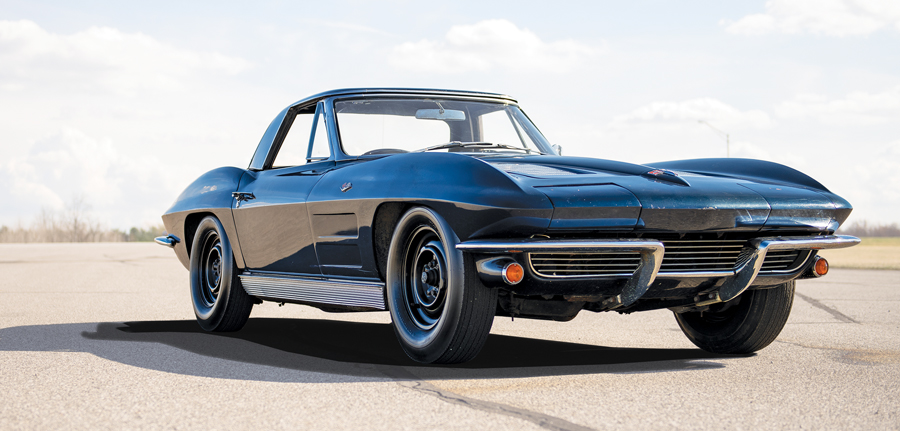- Desirable first-year-production Sting Ray
- 327-ci 340-hp L76 V8
- 4-speed manual transmission
- Daytona Blue exterior
- Dark blue interior
- Significant age- and use-related flaws and patina
- Soft top and hard top included
- 62,948 miles showing
SCM Analysis
Detailing
| Vehicle: | 1963 Chevrolet Corvette 327/340 convertible |
| Years Produced: | 1963 |
| Number Produced: | 10,919 |
| Original List Price: | $4,037 |
| SCM Valuation: | $47,500 |
| Tune Up Cost: | $500 (NOS parts, estimated) |
| Chassis Number Location: | Cross brace under glovebox |
| Engine Number Location: | On block in front of right cylinder head |
| Alternatives: | 1972 Chevrolet Corvette 454 LS5 convertible; 1995 Corvette ZR-1; 2011 Corvette convertible |
| Investment Grade: | B |
This car, Lot 5117, sold for $36,300, including buyer’s premium, at RM Auctions’ Spring auction in Auburn, IN, on May 29 to June 1, 2019.
Way back when this first-year Sting Ray convertible was just a “used car,” preservationists were rare. As early as the mid-1970s, the ethos for car collectors and flippers was to make vehicles look like new with little regard for preserving their originality. Fluff, fold, flip.
Now multiply this by four decades, and the pool of unrestored, time-worn cars has grown dramatically smaller.
Even so, the street value of normal age- and mileage-related character as shown on this car is debatable… at least as determined by the market. Its sale at $11,200 below ACC’s Pocket Price Guide median value figure of $47,500 shows that at least in this case, the market did not value patina well; the condition resulted in a 24% value deduction over the midpoint pricing for other ’63 convertibles.
Why is this, when other segments of the market (Porsches in particular) sometimes reward “barn-find” and “patina” cars?
Pretty okay exterior
There is a huge difference in desirability between a truly “original” car and a similar timeworn ride that’s already been repainted, reupholstered and rebuilt sometime in the distant past.
I’d pay a premium for the former, because such a car, despite its wear and tear, would retain the same paint, interior and key mechanicals that it had when it rolled out of the St. Louis plant.
Unfortunately, the catalog description for this car didn’t specify anything of the sort, nor whether the 340-hp L76 engine, 4-speed gearbox and associated castings were original to the car.
The only clue as to potential body damage is that mis-fitting right headlight door. As well, the paint sheen (reflectivity) varies between the left front fender, left door, left quarter panel and headlight doors… although that could be a photo trick. Regardless, there’s plenty of paint damage — stone chips and scratches — to add character.
As-found frights
Rust, grime and grit reign under the hood. That said, it was made operable, as evidence by new spark-plug wires, distributor cap, alternator belt, ballast resistor, radiator hose, coolant-temperature sending unit, fuel line and filter.
Why no detailing? My guess is the seller was striving for an “as-found” look. At least the presentation was honest; the new parts were appropriate service items and the rest was left alone. Fair enough.
Things look somewhat better inside the car. The convertible was offered with its auxiliary hard top in place, and perhaps this explains why there is significantly less oxidation apparent here. But the instrument bezels, Hurst shift lever and aluminum center console show significant weathering, in particular the dented console metal and torn rubber shift gaiter, which contrasts with a new-looking cue-ball shift knob.
Under the glovebox is more weirdness. The aluminum Trim and Paint tag is oddly bent and torn. The clean VIN tag is riveted atop a worked-over crossbeam. And next to the VIN tag? An unexplained piece of angle iron sloppily attached by a low-grade zinc-plated bolt. At this point, as a buyer, I’d be starting to sidestep away… or else demand some clear answers about the car’s history.
All roads lead to maybe
So what have we got here? On the positive side, it’s a desirable first-year Sting Ray convertible with a lusty engine, a 4-speed Muncie, both tops, and so much patina that you’d drive it anywhere.
On the negative side, it’s a plentiful model year (Corvette production surpassed 20,000 for the first time in 1963), the 340-horse L76 mill was the second-most-popular powerplant that year, nearly 84% of ’63 Corvettes had manual transmissions, and several thousand Daytona Blue examples were built.
Additionally, virtually no part of the car, save the shift knob and perhaps some glass or bumper parts, appears perfect. This means that bringing this below-average example up to “average” condition would likely exceed the $11k divide between what the buyer paid and what better cars are worth.
Translation: The buyer paid too much considering the condition of this car. That is, until you consider the word “patina” again.
In my own collection is a car in even worse condition than this Corvette. And I keep it this way precisely because it is what it is — old, authentic, and thoroughly flawed. I like it for its genuineness and lack of pretentiousness, and don’t mind if it shocks the senses of the concours crowd. In fact, that’s part of the appeal.
And so, to The Buyer Who Paid Too Much for this ’63 convertible, I say well done. We are brothers in alarm.
(Introductory description courtesy of RM Auctions.)
